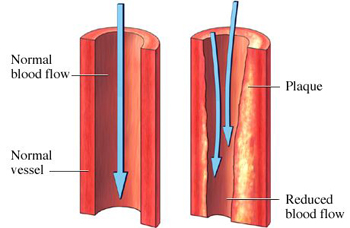March 31, 2008
No Ribbons For Athero

By Michael D. Shaw
The website www.personalizedcause.com offers ribbon pins in 55 colors, covering more than 430 causes. Strangely, missing in the extensive list of causes is atherosclerosis—the progressive buildup of plaque (fatty deposits and other cells) in the walls of your arteries, and a leading cause of coronary heart disease and stroke.
Each year about 1.2 million Americans are diagnosed with coronary heart disease and about 700,000 people will suffer a stroke. In 2004, just these two conditions accounted for 602,000 deaths—more than 25% of all deaths in the United States.
The Greek derivation of the term is certainly graphic enough to send a chill up your spine:
athero = Gruel-like, soft pasty materials–from the Greek athere
sclerosis = induration: The act or process of hardening–from the Greek sklerosis
However, the numbers are even more chilling. Atherosclerosis (athero for short) overwhelmingly contributes to more mortality—approximately half or more of all deaths—and serious morbidity in the Western world than any other disorder. Twice as many people die from athero-based disease than from all forms of cancer COMBINED.
We’ve all seen breast cancer ribbons and ribbon pins, but heart disease is the number one cause of death for American women age 35 and older and kills six times as many women as breast cancer.
Athero often begins in childhood, and usually remains asymptomatic until middle age or later, when organs are finally injured. While any organ or tissue can be affected, athero disease most often manifests in those arteries supplying the heart, brain, kidneys, lower extremities, and small intestine.
Myocardial infarction (heart attack), cerebral infarction (stroke), and aortic aneurysms represent the major consequences of athero. [Infarction = an area of necrosis (death) in a tissue or organ resulting from obstruction of the local circulation]. More than 8 million Americans are affected by some form of peripheral arterial disease (PAD), which refers to blockages restricting circulation in arteries leading to the kidneys, stomach, arms, legs and feet.
In its early stages, PAD symptoms are typically cramping, fatigue, heaviness, pain, or discomfort in the legs and buttocks during strenuous activity—subsiding when the exercise stops, or soon afterward. Symptoms of poor kidney circulation include sudden high blood pressure, or blood pressure that is difficult or impossible to control with medication.
Risk factors for athero include…
- A family history of aneurysm or early heart disease
- Diabetes
- Getting older
- High blood pressure
- High cholesterol
- Obesity
- Smoking
As always, prevention beats treatment, and here are a few things to consider…
- If you smoke, stop!
- Exercise more. Vigorous physical activity can actually promote development of so-called collateral vessels (new circulatory pathways that bypass obstructions).
- Eat healthy
- Manage stress more effectively. Many techniques are available for this, so experiment and find the one that works best for you.
- If you already have risk factors, endeavor to manage them BEFORE you have a problem
There is also some good news in the athero story. Between 1963 (the peak year) and 1995, there was an approximately 50% decrease in the death rate from ischemic heart disease and a 70% decrease in death from strokes, a reduction in mortality that has increased the life expectancy in the US by five years. [N Engl J Med 1997;337:1360-9.]
This trend is driven by lifestyle changes, improved treatment modalities, and prevention of recurrent events. Indeed, the highly-honored Eugene Braunwald, M.D., author of the paper cited, noted that “…as the second half of the 20th century has progressed, the urgency about the pandemic of cardiovascular disease that existed at mid-century has been replaced by growing complacency.”
You owe it to yourself and your loved ones to get up to speed on athero. Here are some good resources:
www.americanheart.org/presenter.jhtml?identifier=4440
www.nhlbi.nih.gov/health/dci/Diseases/Atherosclerosis/Atherosclerosis_All.html
www.usagainstathero.com
Given the monumental cost of health care, doesn’t it make sense to concentrate on the very biggest killer of all?

